Ordinance rule: A throwback to Raj?

The late B.P. Koirala, Nepal’s first democratically elected Prime Minister, who held office for 18 months before King Mahendra had him deposed and imprisoned, once told me that India’s Constitution was nothing more than the Government of India Act of 1935 embellished with Fundamental Rights and Directive Principles. He meant that in some aspects, India’s governance has not changed radically since the British Raj.
One could go beyond that to suggest that one-person-one-vote democracy is seriously flawed, specially in a country whose barely literate masses treat elected leaders like hereditary monarchs or deities, as Tamil Nadu’s love affair with the late J. Jayalalithaa clearly demonstrates. Thomas Babington Macaulay, the historian who gave India its education system, was convinced “the supreme authority in a state” could not “be entrusted to the majority of citizens told by the head, in other words, to the poorest and most ignorant part of society”. But, of course, that is exactly why populist politicians want democracy, Indian style. It enables them to appeal to the instinctive urges of society’s lowest common denominator. Despite the Supreme Court’s order on caste, there is no denying the truth of Bal Thackeray’s observation that “in India people don’t cast their vote, they vote their caste”. It’s the same with religion, ensuring that the world’s largest democracy cleverly camouflages populist authoritarianism in democratic trappings.
Koirala’s stricture came to mind on December 28 when Narendra Modi promulgated an ordinance to sanctify demonetisation. It was only a fortnight after Parliament’s Winter Session had ended so that the opportunity to subject the ban on certain notes to democratic scrutiny was avoided. Earlier, the government had refused the Opposition’s clamorous demand to discuss demonetisation in Parliament. So, although a sweeping measure with far-reaching effects from which we are still suffering was announced and implemented on November 8, there was no proper debate on it even by the time it became law more than seven weeks later through the backdoor tactic of an ordinance. Koirala would have split his sides laughing, for Section 42 of the 1935 Act empowered the Viceroy to issue ordinances while the Central legislature was in recess.
I must hasten to add this was not the first instance of government by ordinance. Nor is Mr Modi the only perpetrator. Indira Gandhi was even more blatant in 1969 when she promulgated an ordinance nationalising 14 major banks only two days before Parliament was due to convene. It’s a wonder the Supreme Court did not comment on such shortcuts earlier but a seven-judge bench did announce in a landmark judgment this month that the Constitution did not sanction a lapsed ordinance being promulgated again. It held that such an ordinance would remain valid only if its continuation was manifestly in the public interest or if it were physically impossible to replace it with an enactment.
This is not the only instance of our supposedly republican regime clinging tenaciously to a viceregal privilege. Article 356 of the Constitution, which authorises the Centre to dismiss a state government, is also derived from the same colonial legislation Indians rejected and Koirala condemned. Dr B.R. Ambedkar, chairman of the Constitution Drafting Committee, did not think Article 356 would ever be used. Asked about its likely abuse, he replied: “I share the sentiments that such articles will never be called into operation and they would remain a dead letter. If at all they are brought into operation, I hope the President, who is endowed with these powers, will take proper precautions before actually suspending the administration of the provinces. I hope the first thing he will do would be to issue a mere warning to a province that has erred, that things were not happening in the way in which they were intended to happen in the Constitution. If that warning fails, the second thing for him to do will be to order an election allowing the people of the province to settle matters by themselves. It is only when these two remedies fail that he would resort to this article.”
Not many would say his advice has been heeded. The imposition of President’s Rule has varied over the decades. Its use — 49 times between 1970 and 1980 — highlighted the polarised political atmosphere in which Article 356 became a political tool. The use — or misuse — of the clause dropped significantly following the Supreme Court’s landmark judgment in the case that a Karnataka chief minister, S.R. Bommai, who felt he had been unfairly dismissed, brought before the court in 1994. The judges stipulated circumspection along the lines Ambedkar had suggested. President’s Rule was imposed five times between 2011 and 2016, including three times by the BJP after coming to power in 2014.
There are many other ways of interfering with the democratic equilibrium. The Planning Commission was one such, being an extra-constitutional centre of authority. The relationship in practice between the ruling party at the Centre and its branches in the states is another. The self-seeking subservience of Indians who praise every action of a prime/chief minister in hopes of reward is probably the worst enemy of the democratic spirit. We see every day the truth of Senator Adlai Stevenson III’s belief that the United States has a democratic government whereas India can claim at the most only representative government. It’s not a question of the system of governance; it’s the software. India’s medieval psychology will transform any system into elective authoritarianism until education teaches people to reject Hegel’s stricture, possibly inspired by India, “The East knew and to the present day knows only that One is Free…” In a democracy everyone has to be free and equal. No one is worshipped as God or King.

